Quick Reference
Painted 1918 - 1919.
Redgate
Oil on Canvas
Landscape
Woods
40" x 50"
Mr. Julius Hallgarten, himself
NA
Related Links
- See also the...
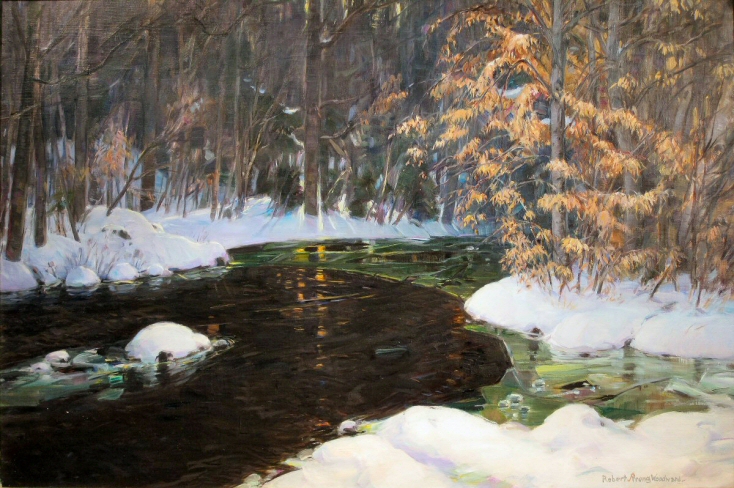 Quintessential Redgate Gallery to view related pieces.
Quintessential Redgate Gallery to view related pieces.
- See our page devoted to ...
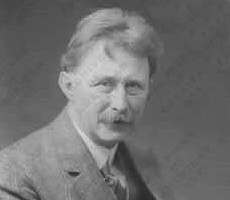 Colrain artist and RSW ally George Gardner Symons
Colrain artist and RSW ally George Gardner Symons
- See also the...
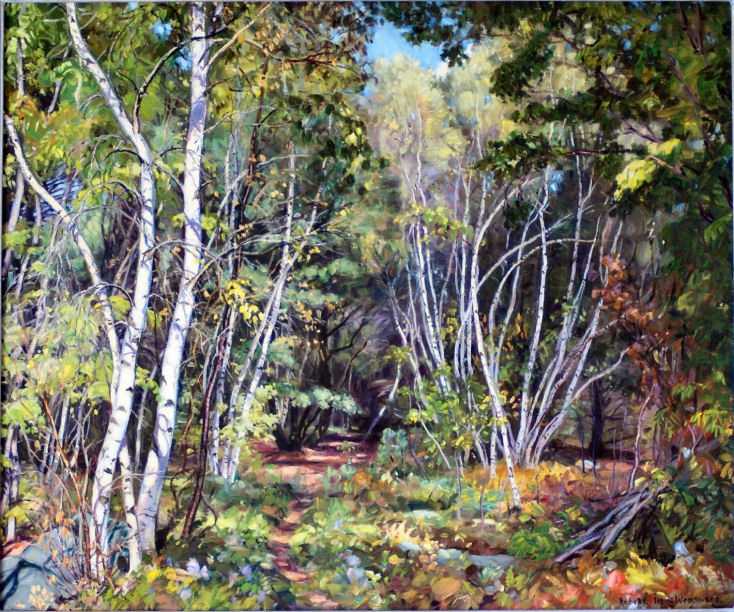 Woods Gallery to view related pieces.
Woods Gallery to view related pieces.
- Woodward was the first recipient on the Hallgarten Prize.
- See also the...
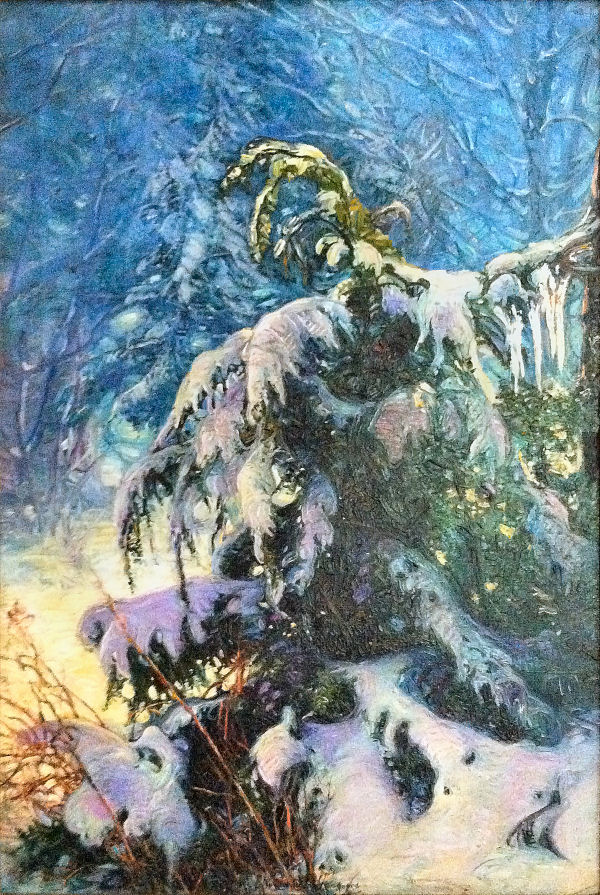 Snow on the Ground Gallery to view related pieces.
Snow on the Ground Gallery to view related pieces.
- See also the...
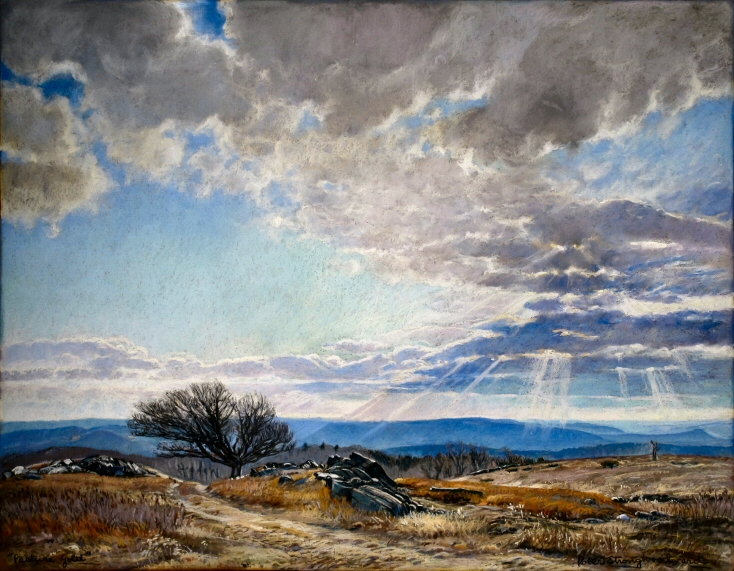 Stunning Skies Gallery to view related pieces.
Stunning Skies Gallery to view related pieces.
- See also the Exhibition List for other Exhibits.
- See also the...
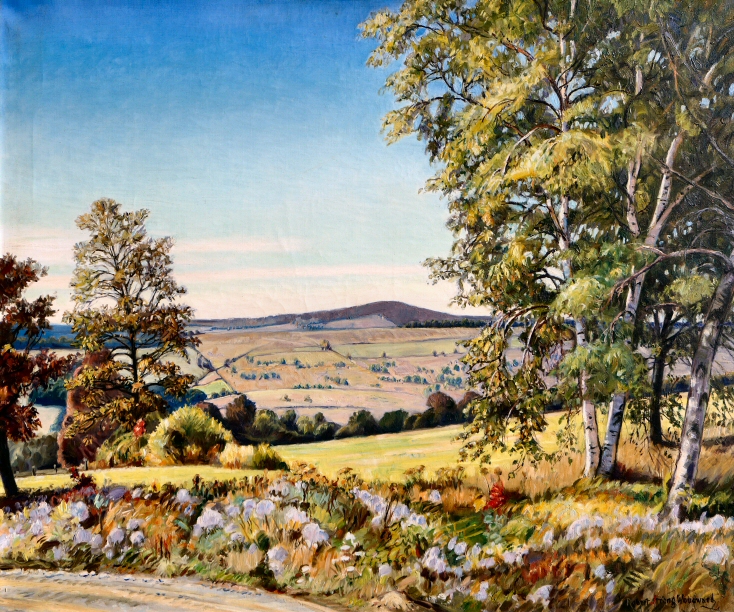 Landscapes & Views Gallery to view related pieces.
Landscapes & Views Gallery to view related pieces.
- See also other Awarded paintings by Woodward.
Related Information
 In the New York Times Magazine article, the writer refers to
Between Setting Sun and Rising Moon as a painting, "that will hardly escape comparison with those of Blakelock..." We believe this is a reference to artist
Ralph Albert Blakelock. Mr. Blakelock would die 5 months after the article was written.
In the New York Times Magazine article, the writer refers to
Between Setting Sun and Rising Moon as a painting, "that will hardly escape comparison with those of Blakelock..." We believe this is a reference to artist
Ralph Albert Blakelock. Mr. Blakelock would die 5 months after the article was written.
Ralph Albert Blakelock,
(1847 -1919), a 19th-century American artist,
is known for his moonlight landscapes and quiet paintings of American Indian encampments.
Below: Is an example of Blakelock's work.


Featured Artwork: Between Setting Sun and Rising Moon 
RSW's Diary Comments
"1918 "1919. The first 40" x 50" I ever made. Urged to do it by Gardner Symons and sent to Spring National Academy Exhibition (N. Y.) where it was awarded the first Hallgarten prize ($300). My first prize, my first prominent public notice! Mr. Hallgarten, himself, bought the painting from the exhibition for $500, a tremendous sum to me at the time. I had been painting in oils only for two years! Have heard nothing of the canvas in recent years and fear it may have darkened or cracked, as I was not aware of the proper mediums to use for lasting results in those days. Feel badly about this possibility. Fine criticism of this canvas in N. Y. Times Magazine of March 30, 1919."
The artist wrote in his own handwriting the following comments on the reproduction printed here:
"Very very poor reproduction. This is so poor I cringe from sending it. I shall get another copy to see if I can"t touch it up with black and white and send it to you."
Comments on the back of a sepia print written in RSW's handwriting:
"The entire left side of this [the sepia print photograph] is a blur and failure. The beautiful mountain up by Purrington's showed thru the trees against the sunset sky and the tree trunk and branch pattern to the left, just a smudge. In this was a beautiful and intricate pattern. I really don't like to have this terrible reproduction seen. Did you read the criticism in the magazine section of the Times? Really a wonderful write-up. The sky pattern turns beautifully to the left giving the composition balance which this reproduction lacks."
Additional Notes
 The Hallgarten prize of $300.00 won at the National Academy, New York, for the painting Between Setting Sun
and Rising Moon which sold the first day of the exhibition.
The Hallgarten prize of $300.00 won at the National Academy, New York, for the painting Between Setting Sun
and Rising Moon which sold the first day of the exhibition.
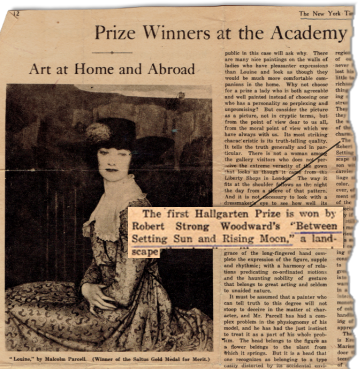
Click on the image to see a
print version of transcription
To view the entire article CLICK HERE
Right: New York Times Magazine, March 30, 1919
Below:Transcribed from the article...
"The first Hallgarten Prize is won by Robert Strong Woodward's Between Setting Sun and Rising Moon, a landscape that hardly will escape comparison with those of Blakelock and that carries on the Blakelock tradition of foliage silhouetted against a sky rich in color. It bears plentiful evidence, however, of original observation in the treatment of the foreground and the drawing of the foliage and lighter branches and especially in the feeling of depth. Probably if it were a smaller picture it would be still more beautiful and satisfying, the monotonous places in it would be less obvious, there would be less suggestion of a mind leaping rather perilously from the earth to the top branches and leaving the intervening forms insufficiently considered. Nothing but praise belongs to the scrupulously considered foreground with its delicate shadows leading into the distance, and to the sky as it warms to red on the horizon and is seen in a wonderfully true value beyond the interlace of the tree screen. Even the monotony of the darker masses is more of color than of form. An intricacy of handling shows that the elaborate weaving of the detail within the mass was appreciated."
Greenfield Gazette and Currier, March, 1919
"....Robert Strong Woodward of Buckland, unable to get out and search for beautiful subjects, has found one from his own window and treated it in such a successful way that it has secured the Hallgarten prize of $300 and in addition it has the distinction of having been purchased by Mr. Hallgarten. This picture, entitled Between Setting Sun and Rising Moon, is said to be unusually beautiful in color. With the mellow light of the hour suggested by the name shining through the trees there is given the impression of a strong foreground with the glory of the afterglow pervading the whole picture. If this is Mr. Woodward's first canvas exhibited at the National Academy of Design, New York City, he is to be congratulated upon his unusual success. Visitors to the exhibition next year will surely be looking for the work of this artist."
New York Times, March, 1919
"The first Hallgarten prize has gone to one of the most individualized of the winter landscapes in Mr. Robert Strong Woodward's Between Setting Sun and Rising Moon, a picture which discloses imagination as well as skill in realistic matters."
Between Setting Sun and Rising Moon
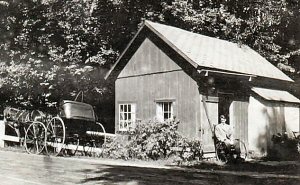
Redgate. RSW's first studio
 Robert Strong Woodward returned to Shelburne Falls in 1910 at the age of 25 and moved into a small shed-apartment
-studio on the farm of his uncle. In about 1915 he began painting in oils and his early paintings were made from
out the rear window of this little studio which he named Redgate. His early paintings were usually very large
(40" x 50") and were made of the large trees and small stream visible out the window of his studio.
Robert Strong Woodward returned to Shelburne Falls in 1910 at the age of 25 and moved into a small shed-apartment
-studio on the farm of his uncle. In about 1915 he began painting in oils and his early paintings were made from
out the rear window of this little studio which he named Redgate. His early paintings were usually very large
(40" x 50") and were made of the large trees and small stream visible out the window of his studio.
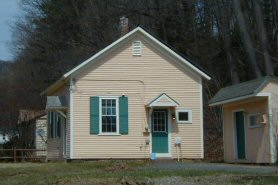
The home and studio of Gardner Symons
 Right: is a photograph of Redgate with RSW in his wheelchair outside. After making several of these paintings
he took them over to Colrain to show to the senior oil painter then living in the area, Gardner Symons.
Mr. Symons worked in a small studio close to the North River Bridge. The studio was painted yellow at the time and is still
painted yellow. A photograph of it is reproduced below.
Right: is a photograph of Redgate with RSW in his wheelchair outside. After making several of these paintings
he took them over to Colrain to show to the senior oil painter then living in the area, Gardner Symons.
Mr. Symons worked in a small studio close to the North River Bridge. The studio was painted yellow at the time and is still
painted yellow. A photograph of it is reproduced below.
 Mr. Symons was very impressed with the work of this new young artist and encouraged him to send one of his paintings
to the New York City National Academy of Design spring exhibitions. It was here in 1919 that RSW won his first
professional recognition.
Mr. Symons was very impressed with the work of this new young artist and encouraged him to send one of his paintings
to the New York City National Academy of Design spring exhibitions. It was here in 1919 that RSW won his first
professional recognition.
Additional Features
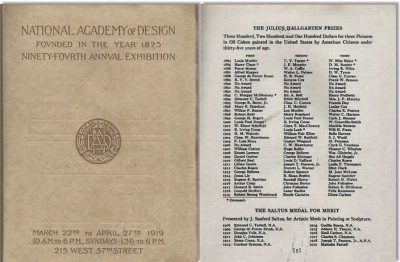
Catalogue Cover and the list of prize winners
To the right:
The Title page of the 94th annual exhibition along with a list of Julius Hallgarten Prize winners. RSW won for 1919. See name listed under the first column (FIRST). His is last name listed.
These scanned copies are from one of three of the brochures left in the files of the National Academy of Design since 1919. It was purchased for $45 from the National Academy Museum by the the courtesy of Laura Zelasnic, Archivist.
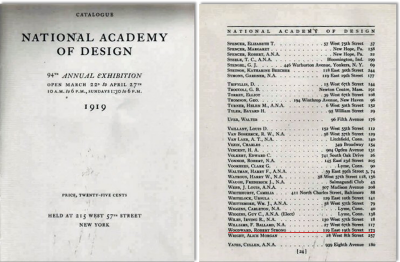
Artist directory with RSW listed having a NYC address
To the left:
From the Catalogue of the 1919 exhibit are names and addresses of the artists in the 1919 exhibition. See Woodward listing near bottom of the page. We have no explanation for RSW having an NYC address at his time, however, it is the same address used for Gardner Symons. The address for the National Art Club.
 When your cursor changes to this symbol, the image can be enlarged simply by clicking on it.
When your cursor changes to this symbol, the image can be enlarged simply by clicking on it.
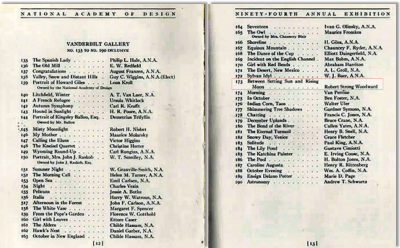
Catalogue Listing, #173
To the right:
Listing of alll of the paintings hung in the Vanderbilt Gallery in 1919. Woodward's name is listed on the right side about a third of the way down(#173).
Also Note: Woodward's friend Gardner Symons is listed 3 artist lower at #177
The catalogue now resides in RSW's Southwick studio.
mlp 2008
 To view all 3 scanned document in a pdf format please CLICK HERE to open a new tab.
To view all 3 scanned document in a pdf format please CLICK HERE to open a new tab.

.png)

